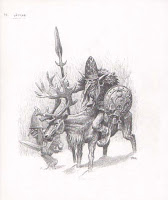Humanoids, Part III: Kobolds

Kobolds wrap up this little mini series on humanoids. Not because they merit a special place or anything. Really, it's just that they didn' fit into the previous two and they have just enough going for them to be mentioned anyway. I should say in advance: It's not a generous treatment. Kobolds, as the lowest hit die humanoid on the block, get the dumpster treatment. With goblins feyed up, made a bit more spooky and capable, Kobolds are the ones left to fill another niche. A quick look at the wiki page for Kobolds shows that kobolds play a very different role than goblins: They are house spirits, mining spirits, sailing spirits, performing menial chores for humanity. In other words, they are a race connected with civilization far more so than the mythic wilderness. And generally, in the garbage end of the hierarchy. Intelligent rats. They are basically sapient vermin. Kobolds in Erce are found in every major city in the west. They live in sewers and slum



